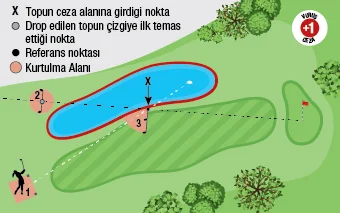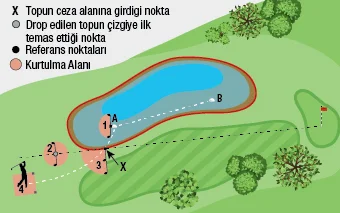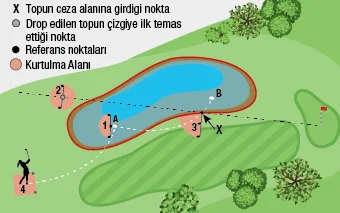Jump to section
Print Section
17Penalty Areas
17
Penalty Areas
Purpose of Rule: Rule 17 is a specific Rule for penalty areas, which are bodies of water or other areas defined by the Committee where a ball is often lost or unable to be played. For one penalty stroke, players may use specific relief options to play a ball from outside the penalty area.
17
Penalty Areas
17.1
Options for Ball in Penalty Area
Penalty areas are defined as either red or yellow. This affects the player’s relief options (see Rule 17.1d).
A player may stand in a penalty area to play a ball outside the penalty area, including after taking relief from the penalty area.
17.1a
When Ball Is in Penalty Area
A ball is in a penalty area when any part of the ball:
- Lies on or touches the ground or anything else (such as any natural or artificial object) inside the edge of the penalty area, or
- Is above the edge or any other part of the penalty area.
17.1b
Player May Play Ball as It Lies in Penalty Area or Take Penalty Relief
The player may either:
- Play the ball as it lies without penalty, under the same Rules that apply to a ball in the general area (which means there are no specific Rules limiting how a ball may be played from a penalty area), or
- Play a ball from outside the penalty area by taking penalty relief under Rule 17.1d or 17.2.
17.1c
Relief for Ball Not Found but in Penalty Area
If a player’s ball has not been found and it is known or virtually certain that the ball came to rest in a penalty area:
- The player may take penalty relief under Rule 17.1d or 17.2.
- Once the player puts another ball in play to take relief in this way:
- The original ball is no longer in play and must not be played.
- This is true even if it is then found on the course before the end of the three-minute search time (see Rule 6.3b).
17.1d
Relief for Ball in Penalty Area
If a player's ball is in a penalty area, including when it is known or virtually certain to be in a penalty area even though not found, the player has these relief options, each for one penalty stroke:
(1) Stroke-and-Distance Relief. The player may play the original ball or another ball from where the previous stroke was made (see Rule 14.6).
(2) Back-on-the-Line Relief. The player may drop the original ball or another ball (see Rule 14.3) outside the penalty area, keeping the estimated point where the original ball last crossed the edge of the penalty area between the hole and the spot where the ball is dropped (with no limit as to how far back the ball may be dropped). The spot on the line where the ball first touches the ground when dropped creates a relief area that is one club-length in any direction from that point, but with these limits:

 (3) Lateral Relief (Only for Red Penalty Area). When the ball last crossed the edge of a red penalty area, the player may drop the original ball or another ball in this lateral relief area (see Rule 14.3):
See Rule 25.4m (for players who use a wheeled mobility device, Rule 17.1d(3) is modified to expand the lateral relief area to four club-lengths).
See Committee Procedures, Section 8; Model Local Rule B-2 (the Committee may adopt a Local Rule allowing lateral relief on the opposite side of a red penalty area at an equal distance from the hole).
(3) Lateral Relief (Only for Red Penalty Area). When the ball last crossed the edge of a red penalty area, the player may drop the original ball or another ball in this lateral relief area (see Rule 14.3):
See Rule 25.4m (for players who use a wheeled mobility device, Rule 17.1d(3) is modified to expand the lateral relief area to four club-lengths).
See Committee Procedures, Section 8; Model Local Rule B-2 (the Committee may adopt a Local Rule allowing lateral relief on the opposite side of a red penalty area at an equal distance from the hole).
- Limits on Location of Relief Area:
- Must not be nearer the hole than the estimated point where the original ball last crossed the edge of the penalty area, and
- May be in any area of the course except the same penalty area, but
- Must be in the same area of the course that the ball first touched when dropped.
ŞEKİL #1 17.1d: SARI CEZA ALANINDAN KURTULMA

Topun sarı işaretli bir ceza alanına girdiği biliniyor veya göreceli olarak kesinse ve oyuncu kurtulma almak istiyorsa, oyuncunun bir vuruş ceza ile uygulayabileceği iki seçeneği vardır. Oyuncu:
(1) Oyuncu vuruş ve mesafe kuralını uygulayarak, bir önceki vurusunu yaptıgı yerde belirledigi kurtulma alanı içerisinden oynayabilir..
(2) X noktasını çukur ile topu drop edeceği nokta arasında tutarak çizgi üzerinde istediği kadar geri gitme seçenegini kullanabilir.
ŞEKİL #2 17.1d: KIRMIZI CEZA ALANINDAN KURTULMA

Topun kırmızı isaretli bir ceza alanına girdigi biliniyor veya göreceli olarak kesin ise oyuncunun bir vurus ceza ile uygulayabilecegi üç seçenegi vardır. Oyuncu:
(1) Bir önceki vuruşun yapılığı yere göre oluşacak olan kurtulma alanından vuruş ve mesafe cezası alabilir.
(2) Ceza alanı dışına, X noktasını çukur ile topun drop edileceği nokta arasında bırakarak çizgi üzerinde geri gitme seçeneğini kullanabilir.
(3) Yana kurtulma alabilir (sadece kırmızı işaretli ceza alanında uygulanabilir). Yana doğru kurtulma alırken referans noktası X'dir, ve çukura daha yakın olmayan iki sopa boyu alan içerisine bir top drop edilip oynanabilir.
- Reference Point: The estimated point where the original ball last crossed the edge of the red penalty area.
- Size of Relief Area Measured from Reference Point: Two club-lengths, but with these limits:
- Limits on Location of Relief Area:
- Must not be nearer the hole than the reference point, and
- May be in any area of the course except the same penalty area, but
- If more than one area of the course is located within two club-lengths of the reference point, the ball must come to rest in the relief area in the same area of the course that the ball first touched when dropped in the relief area.
17.1e
Relief Must Be Taken from Interference by No Play Zone in Penalty Area
In each of these situations, the player must not play the ball as it lies:
(1) When Ball Is in No Play Zone in Penalty Area. The player must take penalty relief under Rule 17.1d or 17.2.
If the player has interference from a no play zone after taking relief under this Rule, the ball must not be played as it lies. Instead, the player must take further relief under Rule 16.1f(2).
(2) When No Play Zone on Course Interferes with Stance or Swing for Ball in Penalty Area. If a player’s ball is in a penalty area, and is outside a no play zone but a no play zone (whether in an abnormal course condition or in a penalty area) interferes with their area of intended stance or area of intended swing, the player must either:
- Take penalty relief outside the penalty area under Rule 17.1d or 17.2, or
- Take free relief by dropping the original ball or another ball in this relief area (if it exists) in the penalty area (see Rule 14.3):
- Reference Point: The nearest point of complete relief from the no play zone.
- Size of Relief Area Measured from Reference Point: One club-length, but with these limits:
- Limits on Location of Relief Area:
- Must be in the same penalty area where the ball lies, and
- Must not be nearer the hole than the reference point.
- When playing the ball as it lies is clearly unreasonable because of something from which the player is not allowed to take free relief (such as when a player is unable to make a stroke because of where the ball lies in a bush), or
- When interference exists only because the player chooses a club, type of stance or swing, or direction of play that is clearly unreasonable under the circumstances.
17.2
Options After Playing Ball from Penalty Area
17.2a
When Ball Played from Penalty Area Comes to Rest in Same or Another Penalty Area
If a ball played from a penalty area comes to rest in the same penalty area or another penalty area, the player may play the ball as it lies (see Rule 17.1b).
Or, for one penalty stroke, the player may take relief under any of these options:
(1) Normal Relief Options. The player may take stroke-and-distance relief under Rule 17.1d(1), back-on-the-line relief under Rule 17.1d(2) or, for a red penalty area, lateral relief under Rule 17.1d(3).
Under Rule 17.1d(2) or (3), the estimated point used to determine the relief area is where the original ball last crossed the edge of the penalty area where the ball now lies.
If the player takes stroke-and-distance relief by dropping a ball in the penalty area (see Rule 14.6) and then decides not to play the dropped ball from where it comes to rest:


- The player may take further relief outside the penalty area under Rules 17.1d(2) or (3) (for a red penalty area) or under Rule 17.2a(2).
- If the player does so, they get one more penalty stroke, for a total of two penalty strokes: one stroke for taking stroke-and-distance relief, and one stroke for taking relief outside the penalty area.
ŞEKİL #1 17.2a: CEZA ALANI İÇİNDEN OYNANAN TOP AYNI CEZA ALANIİÇİNDE KALIRSA

Bir oyuncunun başlama alanından yaptığı vuruş ceza alanındaki A noktasında gidiyor. Oyuncu sonrasında A noktasından bir vuruş daha yapar ve top B noktasında durur. Eğer oyuncu bu durumda kurtulma almak isterse bir vuruş ceza ile dört seçeneği vardır. Oyuncu:
(1)Vuruş ve mesafe kuralına göre ile bir önceki vuruşunu yaptığı yerde (A noktası) belirlediği kurtulma alanı içerisinden, bir top oynayarak kurtulma alabilir. Bu durumda 4. vuruşunu yapar.
(2) X noktasını çukur ile topu drop ettiği nokta arasında bırakarak çizgi üzerinde geri gelme seçeneğini kullanabilir. Bu durumda 4. vuruşunu yapar.
(3) Yana doğru kurtulma alabilir ( Sadece kırmızı işaretli ceza alanında). Bu durumda referans noktası X’dir ve bu noktadan çukura daha yakın olmayan iki sopa boyu kurtulma alanı içerisine bir top drop ederek 4. vurusunu yapar.
(4) Ceza alanı dısından yaptıgı son vurusunu baslama alanından yaptıgı için baslama alanından bir top oynayabilir. Bu durumda 4. vurusunu yapar.
Eğer oyuncu (1) seçeneği seçerse ve sonrasında drop ettiği topu oynamaktan vaz geçerse, oyuncu ilave bir vuruş ceza ile çizgi üzerinde geri gitme, X noktasını baz alarak yana doğru kurtulma veya başlama yerinden yeniden oynama seçeneklerini kullanabilir. Bu durumda 5. vuruşunu yapar.
ŞEKİL #2 17.2a: CEZA ALANI İÇİNDEN OYNANAN TOP CEZA ALANINDAN ÇIKIP, TEKRAR AYNI CEZA ALANI İÇİNDE KALIRSA

Bir oyuncunun başlama alanından yaptığı vuruş ceza alanındaki A noktasında gidiyor. Oyuncu sonrasında A noktasından vuruş yapıyor ve top ceza alanı dışına çıkıp, tekrar X noktasından ceza alanına girerek B noktasında duruyor. Eğer oyuncu bu durumda kurtulma almak isterse bir vuruş ceza ile dört seçeneği vardır. Oyuncu:
(1) Oyuncu vuruş ve mesafe cezası ile bir önceki vuruşunu yaptığı yerde (A noktası) belirlediği kurtulma alanı içerisinden, bir top oynayarak kurtulma alabilir. Bu durumda 4. vuruşunu yapar.
(2)Oyuncu çizgi üzerinde istedigi kadar geri gitme seçenegini kullanıp, X noktasını (topun ceza alanı sınırını geçtiği nokta) çukur ile topun drop edileceği nokta arasında bırakarak bir top drop edebilir. Bu durumda 4. vurusunu yapar.
(3)Yana kurtulma alabilir (sadece kırmızı ceza alanında). Bu durumda referans noktası X’dir ve bu noktadan çukura daha yakın olmayan iki sopa boyu kurtulma alanı içerisine bir top drop ederek 4. vurusunu yapar.
(4) Ceza alanı dısından yaptıgı son vurusunu baslama alanından yaptıgı için baslama alanından bir top oynayabilir. Bu durumda 4. vurusunu yapar.
Eğer oyuncu (1) seçeneği seçerse ve sonrasında drop ettiği topu oynamaktan vaz geçerse, oyuncu ilave bir vuruş ceza ile çizgi üzerinde geri gitme, X noktasını baz alarak yana doğru kurtulma veya başlama yerinden yeniden oynama seçeneklerini kullanabilir. Bu durumda 5. vuruşunu yapar.
17.2b
When Ball Played from Penalty Area Is Lost, Out of Bounds or Unplayable Outside Penalty Area
After playing a ball from a penalty area, a player may sometimes be required or choose to take stroke-and-distance relief because the original ball is either:
- Out of bounds or lost outside the penalty area (see Rule 18.2), or
- Unplayable outside the penalty area (see Rule 19.2a).
- The player may take further relief outside the penalty area under Rule 17.1d(2) or (3) (for a red penalty area) or under Rule 17.2a(2).
- If the player does so, they get one more penalty stroke, for a total of two penalty strokes: one stroke for taking stroke-and-distance relief, and one stroke for taking relief outside the penalty area.
17.3
No Relief under Other Rules for Ball in Penalty Area
When a player’s ball is in a penalty area, there is no relief for:
- Interference by an abnormal course condition (Rule 16.1),
- An embedded ball (Rule 16.3), or
- An unplayable ball (Rule 19).